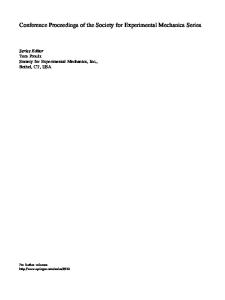Experimental Study on Damage and Fracture Characteristics of Beishan Granite Subjected to High-temperature Treatment wit
- PDF / 7,656,572 Bytes
- 23 Pages / 595.276 x 790.866 pts Page_size
- 104 Downloads / 283 Views
ORIGINAL PAPER
Experimental Study on Damage and Fracture Characteristics of Beishan Granite Subjected to High‑temperature Treatment with DIC and AE Techniques Shuting Miao1,2 · Peng‑Zhi Pan1,2 · Xingguang Zhao3 · Changyue Shao1,2 · Peiyang Yu1,2 Received: 18 January 2020 / Accepted: 5 October 2020 © Springer-Verlag GmbH Austria, part of Springer Nature 2020
Abstract The effect of high temperatures up to 800 °C on the physical and mechanical characteristics and fracturing behaviour of Beishan granite is experimentally studied with a combination of acoustic emission (AE), digital image correlation (DIC) and optical microscope observations. The experimental results show that the responses of the P-wave velocity, the effective porosity, Young’s modulus, and the uniaxial compressive strength (UCS) of the granite to temperature are different. The critical temperature for the brittle–ductile transition of Beishan granite is between 500 and 600 °C. The counts, cumulative energy, b value, and waveform from AE and the full-field deformation evolution from DIC are combined to investigate the damage evolution and fracture mechanism in heated granite. It is found that a rise in temperature increases the number of AE events but reduces the cumulative energy release. Tensile microcracking mainly occurs in granite exposed to low temperatures, while shear fracturing gradually dominates in granite exposed to higher temperatures. With increasing temperature from 25 to 800 °C, the failure mode of granite specimens changes from being controlled by longitudinal splitting cracks to a single shear fracture and finally to multiple conjugate shear fractures. Microscopic observation of granite thin sections is conducted to further reveal the essential mechanism driving the physical–mechanical response and fracturing behaviour of heated Beishan granite. Keywords High temperature treatment · Physical–mechanical characteristics · Acoustic emission · Digital image correlation · Thermally induced microcracks
1 Introduction For engineering rock masses, temperature is a main factor affecting the physical–mechanical properties of rocks (Andersson et al. 2009; Yavuz et al. 2010). Due to the great demand for high-temperature applications in geological science and geotechnical engineering in recent years, various studies have focused on understanding the effects * Peng‑Zhi Pan [email protected] 1
State Key Laboratory of Geomechanics and Geotechnical Engineering, Institute of Rock and Soil Mechanics, Chinese Academy of Sciences, Wuhan 430071, Hubei, China
2
University of Chinese Academy of Sciences, Beijing 100049, China
3
CNNC Key Laboratory on Geological Disposal of High‑Level Radioactive Waste, Beijing Research Institute of Uranium Geology, Beijing 100029, China
of high temperature on the mechanical response and fracture characteristics of rock, which are critical and beneficial for many deep geological applications, including the deep geological disposal of high-level radioactive nuclear waste, practical gasification of coal and
Data Loading...











